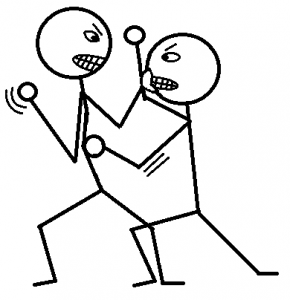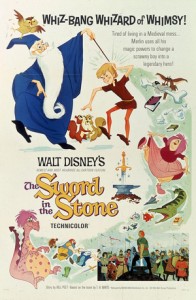Conflict is central to fiction. Not all conflict is violent, of course, but at some point, one of your stories might require a fight scene. Therefore, even if it’s distasteful to you, it’s best if you learn how to write such scenes.
 Violent interactions can take many forms beyond individual combat. These include war, rape, terror, shooting sprees, etc. This post focuses on fights between two characters, but many of my suggestions apply to other situations.
Violent interactions can take many forms beyond individual combat. These include war, rape, terror, shooting sprees, etc. This post focuses on fights between two characters, but many of my suggestions apply to other situations.
People use a variety of weapons when fighting, including bare hands and feet, clubs, knives, swords, guns, any object available in the environment, and a wide array of science fiction or fantasy weapons. Again, most of the guidelines for fight scenes are general, and applicable to any weapon type.
For the following list of fight scene rules, I drew from, and combined, ideas from the following people’s blogs: Joanna Penn, Angela Bourassa, Amber Argyle, and the contributors to Wikihow. They’re all great sources of information, and I recommend you read each one. Now, here’s my list:
- If possible, observe a real fight. Note offensive and defensive movements, tempo, exploitation of speed vs. strength, etc.
- Study fictional fight scenes written by great writers. Pay attention to details selected, sentence structure, word choices, and techniques used to heighten tension.
- Ensure your scene is relevant to, and advances, your plot.
- Consider using the fight to reveal or further develop the characters’ personalities, and maybe the story’s theme.
 My favorite example of this is the “wizard’s duel” in the Disney movie The Sword in the Stone. During their fight, Merlin and Madam Mim are each turning themselves into various animals. Madam Mim’s animals emphasize power and strength; Merlin’s emphasize cunning and intelligence. The superiority of brain over brawn is the lesson Merlin has been trying to teach young Arthur, and is the major theme of the movie.
My favorite example of this is the “wizard’s duel” in the Disney movie The Sword in the Stone. During their fight, Merlin and Madam Mim are each turning themselves into various animals. Madam Mim’s animals emphasize power and strength; Merlin’s emphasize cunning and intelligence. The superiority of brain over brawn is the lesson Merlin has been trying to teach young Arthur, and is the major theme of the movie. - Ensure you’ve established that both characters have appropriate motivation. Why is each one fighting? What does he or she hope to gain by winning? That helps the reader care about the outcome.
- Break up the lunges, punches, slices, gunshots, etc.—the mechanics and logistics of the fight—with short dialogue or description to keep from boring the reader. When using dialogue, skip the ‘said.’
- Don’t overdo the description of the fight itself; trust the reader’s imagination to fill in such details.
- Use short sentences, with few adjectives or adverbs.
- Weave in all five senses in the fight, to put the reader there.
- Show the Point of View character’s thoughts and emotions as the fight goes on. This is as important as the description of the fight itself.
- Ensure your word choices and detail selections are appropriate to the genre and your intended audience. A fight in a military thriller must be accurate, believable, and authentic. A fight in a romantic adventure should focus on the POV character’s feelings.
- Don’t forget about the aftermath of the fight, how much the POV character hurts, his or her feelings about the opponent, thoughts about whether the fight was worth it, etc.
- In subsequent drafts, cut to the minimum.
It’s my hope these rules will help you write effective and compelling fight scenes in your stories.
Not to brag, but your characters couldn’t last one round with characters written by—
Poseidon’s Scribe
